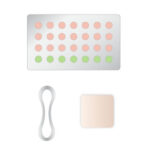 Oral Contraceptive Pills (OCPs), the Patch, and Vaginal Ring
Oral Contraceptive Pills (OCPs), the Patch, and Vaginal Ring
Hormonal treatment including birth control pills, the patch, and the vaginal ring may be taken cyclically (with a week break) or continuously. Continuous hormonal treatment particularly with the pill or ring may be suggested by your health care provider for heavy periods, PCOS, endometriosis, or just for convenience.
What is hormonal treatment?
Birth control pills, also called oral contraceptive pills (OCPs), the patch, and the vaginal ring are all hormonal medicine or treatments. They contain the hormones estrogen and progestin, which are similar to the hormones that the ovaries normally make. There is also another type of OCP that contains only one hormone (progestin), and is called the “progestin–only pill.”
How do I know if I can take hormone treatment?
Most adolescents can take hormonal treatment but some cannot. Before you are offered hormonal treatment, your health care provider will ask you questions about your medical history, such as whether you or anyone in your family has a history of blood clots. You will also be asked about migraine headaches. You may take a progestin-only method (progestin–only pill) if there is a medical reason why you should not take estrogen.
What is continuous use vs cyclic use?
Cyclic use means taking active hormone medicine for a set amount of time, followed by a week of no hormone treatment. The week of no hormone treatment may mean taking placebo pills (pills without hormones), or not taking anything at all. Most adolescents will have their period during the week of no hormone treatment.
*Continuous use means using a hormone treatment such as oral contraceptive pill (OCPs), the patch or vaginal ring continuously without any breaks. Using the OCP and the ring continuously is commonly prescribed. Some health care providers may prescribe a break (pill free week) every 3 months (84 days).
- Oral Contraceptive Pills (birth control pills) – One active hormone pill is taken at the same time every day.
- Patch – A new patch is applied each week.
- Vaginal Ring– Once inserted, the ring is left in place. After 3 full weeks, the ring is removed and a new one is inserted right away.
Are there medical benefits of taking hormonal treatment?
Yes. If you are taking continuous hormonal treatment, you probably won’t have a period. Some adolescents may have spotting or irregular bleeding. You will likely have less cramping, less PMS (premenstrual syndrome) symptoms, fewer headaches, less unwanted hair and improved acne. Hormonal treatment also lowers your chance of getting endometrial (lining of the uterus) cancer, ovarian cancer, and ovarian cysts.
What are the side effects of continuous hormonal treatment?
Most adults and teens have no side effects when taking hormonal treatment, but some may have mild side effects. Each type of hormonal treatment can affect each person differently.
Spotting: Breakthrough bleeding may occur but this is not serious. If it happens, it is usually during the first 2-3 months of taking continuous hormonal treatment and it usually stops. If the bleeding is heavier than spotting or a light flow, or it lasts for more than a few days, tell your healthcare provider. If you are using continuous oral contraceptive pills, it is very important that you take them at exactly the same time every day to keep your hormone levels in balance. This will lower the chance of having breakthrough bleeding. If you are even 20 minutes late, you may have irregular bleeding.
Nausea: You may feel queasy or nauseous at times, but this feeling usually goes away. If you take oral contraceptive pills (OCPs), try to take them with a meal or a snack or at bedtime. Avoid taking them in the morning (especially with no breakfast). If the nausea doesn’t go away, talk to your healthcare provider. He or she may prescribe an OCP with less estrogen.
Headaches: Some young adults may get mild headaches when they start hormonal treatment. Although headaches usually happen because of stress or other reasons, be sure to let your health care provider know if the headaches are severe or if they continue.
Mood changes: Mood changes or mood swings can happen when taking hormonal treatment. Exercise and a healthy diet may help, but if they don’t, you may need to talk to your healthcare provider about possibly changing the brand or type of continuous hormonal treatment that you are taking.
Acne: Hormonal treatment usually helps to lessen and in some cases, cure acne, but some teens may get acne from a certain hormonal treatment.
Weight: Some teens gain weight, some lose weight, but most teens stay exactly the same when they are taking continuous hormonal treatment.
Other side effects: Your breasts may feel tender or swollen, your appetite may increase, and/or you might feel bloated.
Most often, side effects go away within the first few months of using continuous hormonal medicine. If the side effects are severe or if they don’t go away after three cycles, your health care provider may switch you to a different hormonal treatment.
Are there serious effects I should watch out for while taking hormonal treatment?
Most young adults who are on hormonal treatment have few or no problems. However, if you have any of the following symptoms, go to the closest emergency room right away.
- Abdominal pain (severe)
- Chest pain (severe), cough, shortness of breath
- Headache (severe), dizziness, weakness, or numbness
- Eye problems (vision loss or blurring), speech problems
- Severe leg pain (calf or thigh)
Remember: ACHES
Continuous Oral Contraceptive Pills (OCPs)
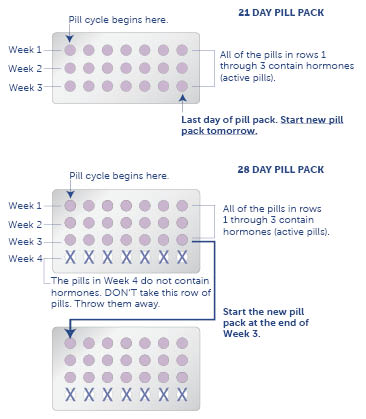
Instructions:
- You will take an active pill at the same time, every day.
- The best time to take your pill is whenever you’ll remember to take it AT THE SAME TIME EACH DAY. You should set multiple alarms on your phone so you are not late. You should also change the time to account for daylight savings time or if you travel to a different time zone, so that the medication is taken every 24 hours.
- When you finish your pill pack, start the next pack and continue taking one pill, at the same time, each day.
Continuous Oral Contraceptive Pills (OCPs) during Daylight Savings Time and Traveling
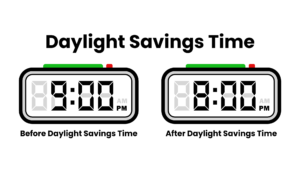
Figure 1. Daylight saving time goes from March to November, check your calendar for exact dates.
When Traveling:
List of countries that observe DST can be found here.
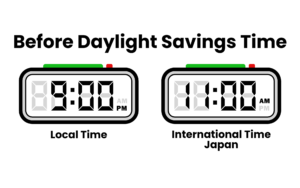
Figure 2. Example of how to manage administration of your medication when traveling to France from EST time zone. (Before Daylight Savings Time is from November-March, check your calendar for exact dates.)

Figure 3. Example of how to manage administration of your medication when traveling to France from EST time zone during Daylight Savings Time. (DST is from March-November, check your calendar for exact dates.)
Continuous Use of the Patch
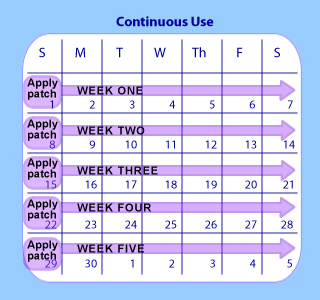
Instructions:
- You will always wear a patch.
- Remove your patch and apply a new patch once a week, on the same day.
Continuous Use of the Vaginal Ring
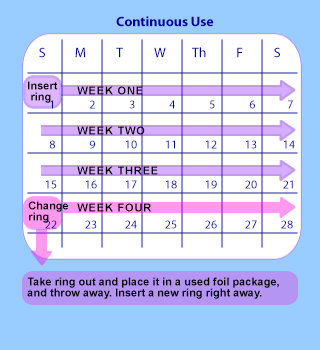
Instructions:
- You will always wear a ring in your vagina.
- After 3 full weeks of wearing the vaginal ring, take it out and replace it with a new one.
- Always change it on the same day of the week.
Our health guides are developed through a systematic, rigorous process to ensure accuracy, reliability, and trustworthiness. Written and reviewed by experienced healthcare clinicians from Boston Children's Hospital, a Harvard Medical School teaching hospital and consistently ranked as a top hospital by Newsweek and U.S. News & World Report, these guides combine clinical expertise, specialized knowledge, and evidence-based medicine. We also incorporate research and best practices from authoritative sources such as the CDC, NIH, PubMed, top medical journals, and UpToDate.com. Clinical specialists and subject matter experts review and edit each guide, reinforcing our commitment to high-quality, factual, scientifically accurate health information for young people.